Percutaneous radiofrequency ablation (RFA) in the management of renal tumours – own experience
Authors:
Petr Morávek jr. 1; Petr Morávek 1; Petr Dvořák 2; Petr Hoffmann 2; Jaroslav Pacovský 1; Pavel Navrátil 1
Authors‘ workplace:
Urologická klinika LF UK a FN, Hradec Králové
1; Radiologická klinika LF UK a FN, Hradec Králové
2
Published in:
Ces Urol 2010; 14(2): 104-109
Category:
Original article
Overview
Aim:
Evaluation of clinical experience with percutaneous RFA of kidney tumours in the period 2006–2008 and indication for this method.
Material and methods:
Overall 36 kidney tumours in 33 patients were enrolled to the prospective study; 53 RFA operations were carried out. The operation was done by the Star-Burst instrument (RITA Medical system) under CT control under a local anaesthesia. Patients were admitted for a one day hospitalisation. Indications for RFA were serious comorbidities contraindicating open surgery, tumour in anatomically or functionally solitary kidney and tumours in chronicaly insuffitient kidneys. Check-up of renal functions, chest X ray and local tumour kontrol (loss of its opacification and retraction of surrounding tissue on CT with kontrast medium) were used to provide in all patients. Mean follou-up time was 18 months.
Results:
One step RFA was successful at 24 tumours (66.66%), the reRFA in 6 month for 12 residues was successful for 7 times (86.1% out of total number of tumours ) and rereRFA in next 6 month was partial successful (partial ablation) at remaining tumor residues. Four patients died (the two from the metastatic tumour, the one from chronic renal insufficiency, the one from comorbidities).
Conclusion:
The percutaneous RFA is considered to be a suitable miniinvasive Alternative method of an ablative treatment of a kidney tumour up to size of 4 cm by prenomiate group of patients.
Key words:
kidney tumours, radiofrequency ablation (RFA).
Sources
1. Murphy DP, Gill IS. Energy-Based renal tumor ablation: a Review. Semin Urol Onkol 2001; 19(2): 133–140.
2. Janzen N, Zisman A, Pantuck AJ, et al. Minimally invasive ablative approaches in the treatment of renal cell carcinoma. Urol Rep 2002; 3(1): 13–20.
3. Ogan K, Cadeddu JA. Minmally invasive Management of the small renal tumor:Review of laparoskopic partial nephrectomy an d ablative techniques. J Endourol 2002; 16(9): 635–643.
4. Chan JL, Panther SE. New technologies for ablation of small renal tumours: Current Status. Can J Urol 2002; 9(4): 1576–1582.
5. Shingleton WB, Sewell PE. jr. Percutaneous cryoablation of renal tunours in patients with von Hippel-Lindau disease. J Urol 2002; 167(3): 1268–1270.
6. Pavlovich CP, Walther MM, Choyke PL, et al. Percutaneous radio-frequency ablation of small renal tumours: Initial results. J Urol. 2002; 167(3): 10–15.
7. Desai MM, Gill IS. Current status of cryoablation and radiofrequency ablation in the management of renal tumours. Curr Opion Urol 2002; 12(5): 387–393.
8. Long L, Park S. Differences in patterns of care: reabalation and nephrectomy rates after needle ablation therapy for renal masses stratified by medical speciality. J Endourol 2009; 23(3): 421–426.
9. Kunkle DA, Uzzo RG. Cryoablation or radiofrequency ablation of the small renal mass: a meta analysis. Cancer 2008; 113(10): 2071–2080.
10. Levinson AV, Su LM, Agarwal D, et al. Long-term oncological and overall outcomes of percutaneous radiofrequency ablation in high risk surgical patients with a solitary renal mass. J Urol 2008; 180(2): 499–504.
11. Mylona S, Kokkinaki A, Pomoni M, et al. Percutaneous radiofrequency ablation of renal cell carcinomas in patients with solitary kidney: 6years experience. Eur J Radiol 2009; 69(2): 351–356.
12. Watanabe F, Kawasaki T, Hataba Y, et al. Radiofrequency ablation for the treatment of renal cell carcinoma initial experience. Radiat med 2008; 26(1): 1–5.
13. Krambeck AE, Farell MA, Callstrom MR, et al. Radiofrequency ablation of renal tumors in the solitary kidney. Can J Urol 2008; 15(4): 4163–4168.
14. Veltri A, Garetto I, Pagano E, et al. Percutaneous RF thermal ablation of renal tumors: is US guidance really less favorable than other imaginig guidance techniques Cardiovasc Intervent Radiol 2009; 32(1): 76–85.
15. Carafiello G, Lagana D, Ianniello A, et al. Percutaneous rediofrequency thermal ablation of renal cell carcinoma : Is it possible a day-hospital treatment? Int J Surg 2008; 6(Suppl 1): S31–S35.
16. Davenport MS, Cavili EM, Cohan RH, et al. MRI and CT characteristics of success fully ablated renal masses: Imaging surveillance after radiofrequency ablation. ARJ AM J Roentgenol 2009; (192(6): 1571–1578.
17. Arima K, Yamakado K, Kintara H, et al. Percutaneous radiofrequency ablation with transarterial embolisation is useful for treatment of stage1 renal cell carcinoma with surgical risk: Results at 2-year mean follow up. Int J Urol 2007; 14(7): 585–590.
18. Matevossian E, Novotny A,Vogelsang B, et al. Noninvasive therapy of incidental de novo renal cell carcinoma in a kidney allograft 12 years after transplantation: Report of a case and review of literature. Transplant Proc 2008; 40(4): 915–917.
19. Stern JM, Merrit ME, Zeltser I, Roman JD, Cadeddu JA. Phase one pilot study usány magnetic resonance spectroscopy to predict the histology of radiofrequencyablated renal tissue. Eur Urol 2009; 55(2): 433–438.
20. Michaličková Z, Červenková J, Hořejš J. Zkušenosti s použitím kontrastní ultrasonografie při hodnocení efektu radiofrekvenční ablace jater a ledvin. Ces Radiol 2009; 63(2): 145–151.
21. Stern JM, Svatek R, Park S, et al. Intermediate comparison of partial nephrectomy and radiofrequency ablation for clinical T1a renal tumours. BJU Int 2007; 100(2): 287–290.
22. Park S, Cadeddu JA. Outcomes of radiofrequency ablation for kidney cancer. Cancer Control 2007; 14(3): 205–210.
23. Hoffman P, Dvořák P, Morávek P, Šafránek H. Perctutaneous radiofrequency ablation of the renal tumours.Initial clinical experience with minimally invasive therapy. Rozh Chir 2007; 86(9): 494–499 (Article in Czech).
Labels
Paediatric urologist Nephrology UrologyArticle was published in
Czech Urology

2010 Issue 2
Most read in this issue
- Less common causes of dysuria in women
- Percutaneous radiofrequency ablation (RFA) in the management of renal tumours – own experience
- Advanced methods of external-beam radiation therapy in the treatment of prostate cancer
- Complications of treatment with bacillus calmette-guerin (BCG) in nonmuscle - invasive bladder cancer
